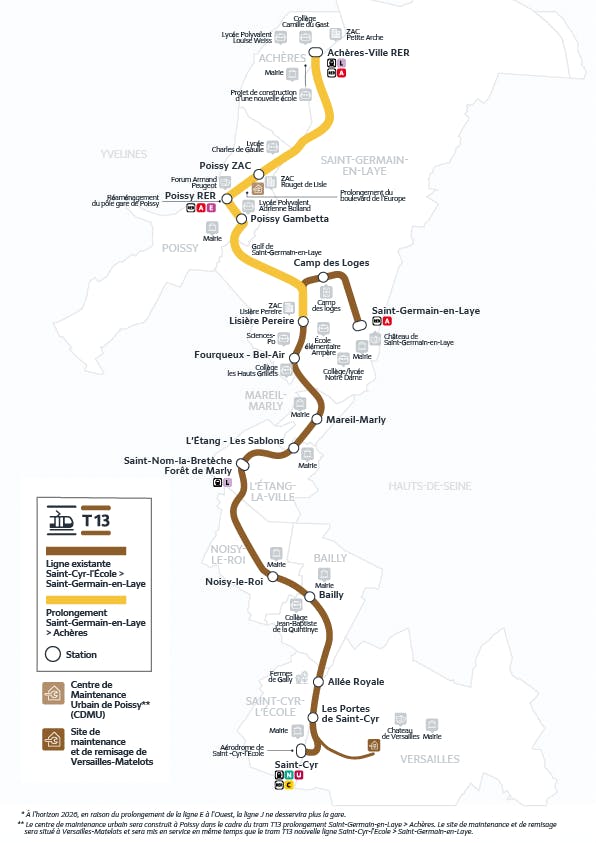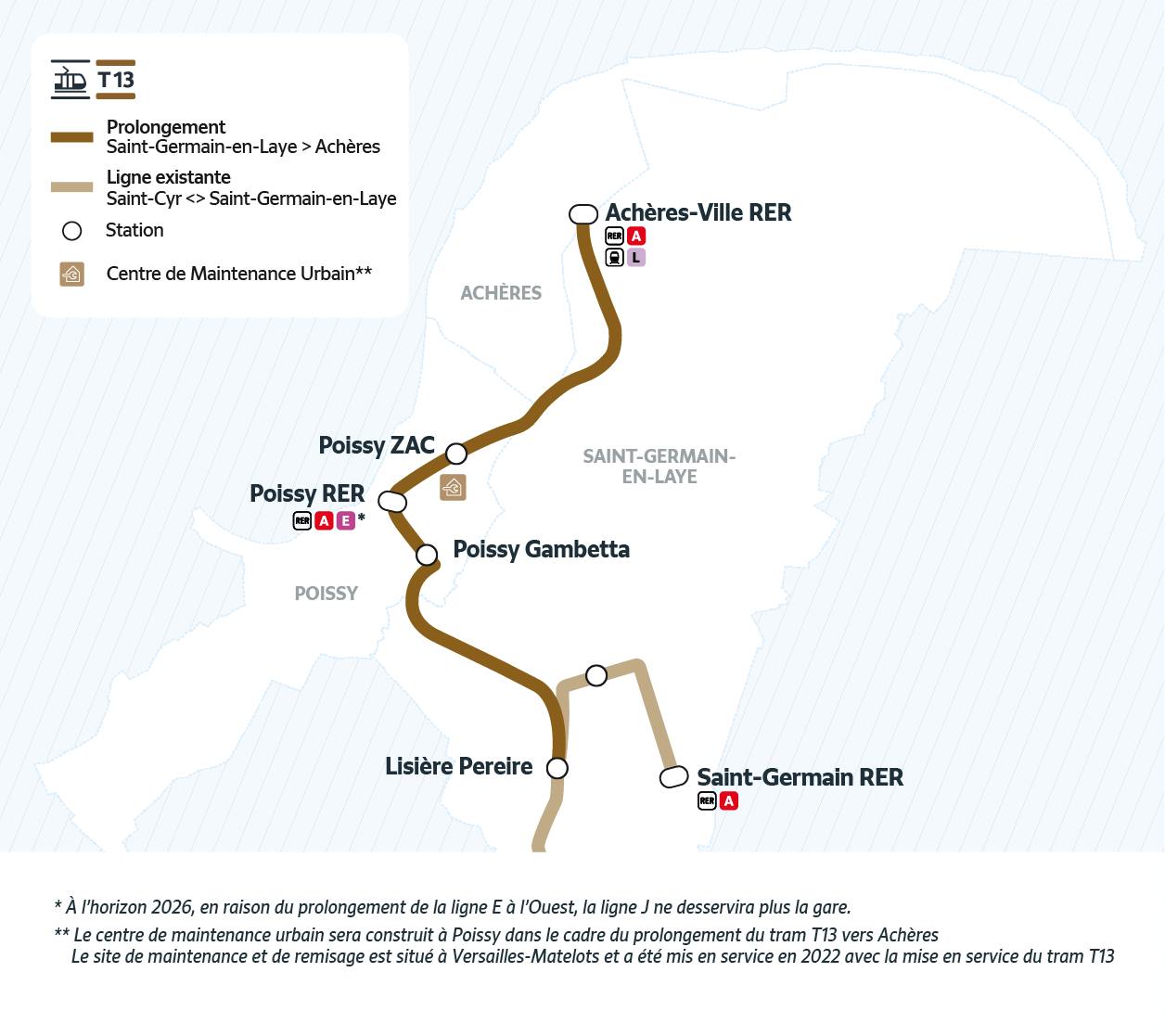The route

The route of the T13 tram...

The complete line
Eventually, the complete T13 tram line will serve a total of 9 municipalities from the north to the south of the Yvelines: Achères, Poissy, Saint-Germain-en-Laye, Mareil-Marly, L'Étang-la Ville, Noisy-le-Roi, Bailly, Saint-Cyr-l'École and Versailles. More than 316,000 inhabitants and 138,000 jobs benefit from this new transport offer.

The extension
Providing a link of about 10 km via Poissy, the extension of the T13 tram between Saint-Germain-en-Laye (Lisière Pereire) and Achères will allow you to quickly reach the busiest sectors and facilities in the area.
... In detail
The tramway will use the right-of-way of the old railway ring in train mode , crossing the forest and the golf course of Saint-Germain-en-Laye. Several bridges will be created or modified to cross the tram tracks: the future Mare aux Bœufs bridge will include a passage for golf course users, a forest path and a passage for wildlife. A second wildlife crossing will be built near the current Pont des Volières. Finally, the two existing level crossings will be replaced by underpasses.
Leaving the forest, the T13 tram will pass through a transition zone before entering Poissy in "tramway" mode, on the rue de la Bruyère. The two bridges of the former major railway ring will be removed, allowing the urban and landscaping redevelopment of the two crossroads they overlooked.
The tramway will arrive at the "Poissy Gambetta*" station located near the Erard Prieur square, which will be redeveloped. It will then be inserted on one side of Avenue de Versailles, bordered by a new cycle lane in the uphill direction, then in the centre of Boulevard Gambetta. The tramway will then merge into Boulevard Gambetta between the two lanes. About fifteen parking spaces will also be restored.
Located upstream from the Place de l'Europe, the "Poissy RER*" station will offer a connection with the Poissy multimodal hub. The tram will then cross the crossroads of Europe. Two lanes per direction of traffic will be created at the intersection between Boulevard Gambetta and Place de l'Europe.
The T13 tram will then pass on the side of the Boulevard de l'Europe, which will be extended, along the railway tracks. The tram will continue along Rue Saint-Sébastien to the "Poissy ZAC*" station. A cycling continuity will be created as part of the project on Boulevard de la Paix. New pedestrian and cyclist accesses will be built to connect the station to the future ZAC of 2,000 housing units as well as to the Saint-Exupéry district.
The tramway will be inserted into Rue Adrienne Bolland along the existing road and visual protection, vis-à-vis the RER tracks, will be created as part of the project.
At the end of Rue Adrienne Bolland, the tramway will once again enter the forest and will once again merge into the Grande Ceinture to cross the existing rail network. It will then take a new platform along the railway tracks and then a new rail bridge to cross the road to the bell tower of Achères before leaving the forest.
The tramway will reach the terminus, the "Achères-Ville RER*" station, at Avenue de Conflans. A secure bicycle locker will be created there.
*Station names are provisional.
Evolution of the route
Why did the possibility of a station at the Achères technopark have to be abandoned?
The extension of the T13 Tram will therefore have 4 stations :
- Poissy Gambetta*,
- Poissy RER*,
- Poissy ZAC*,
- Achères-Ville RER*
*Working names
In the project presented to the 2014 public inquiry, a so-called Achères Chêne feuillu station was planned as a precautionary ticket. It was intended to be carried out not in the time frame of the commissioning of the T13 Tram extension but in the run-up to the commissioning of the New Paris Normandy Line, with which a connection was planned in order to facilitate connections with the other branches of the RER A and the trains at Saint-Lazare station.
In the project presented to the 2014 public inquiry, the extension of the T13 tram was to be entirely part of the Grande Ceinture with only 2 new stations: Poissy Grande Ceinture and Achères Ville RER.
The conclusion of the 2014 public inquiry was characterised by a strong demand for service to the city centre of Poissy, which led the commission to prescribe an additional public inquiry. The studies have therefore continued on this basis.
In 2015, the Board of Directors of Île-de-France Mobilités approved the continuation of the studies of this new urban route with the creation of new stations: Poissy Gambetta, Poissy RER and Poissy ZAC. In the same deliberation, Île-de-France Mobilités recorded the abolition of the Chêne feuillu precautionary measure due to the proximity to the Poissy ZAC station and the ability to transfer to the Poissy RER station to use the RER E and A and line J. These connections offered by the urban variant of the T13 Tram extension will indeed meet the same needs as the planned connection with the New Paris Normandy Line.
In addition to these historical elements, there are the following reasons:
🌳 Environmental constraints
The area is partly classified as a "protection forest", limiting human intervention. This classification was established after the declaration of public utility of the project and takes into account the current route of the tram but no longer allows for major modifications such as the addition of a new station.
🛤️ Too great an impact on the forest and rail traffic
The tram runs on a single track in this area. Adding a station would require a switch to double track, which would result in:
- More land clearing
- The reconstruction of railway bridges, one of which supports the RER A and line J, requiring their traffic to be disrupted
🚶 Complex access facilities
The shutdown would have required major work to compensate for the difference in height with the Route des Loges:
- Access ramps, elevators, escalators
- Parking spaces and bus access, further increasing the impact on the protected forest
⏳ Consequences on the operation of the tram
Modifying the track plan would have had a direct impact on the service :
- Longer journey time between Saint-Germain and Achères
- Reduction in frequency during rush hour, from 10 to 12 minutes on average
🔎 What are the alternatives?
- Reorganisation of the bus network : two years before the tram is put into service, consultation with the cities, Île-de-France Mobilités and local bus service operators will make it possible to optimise bus lines to better serve areas not covered by the tram.
- Cycling facilities : infrastructure for bicycles could be set up under the responsibility of local authorities, with the support of Île-de-France Mobilités.

